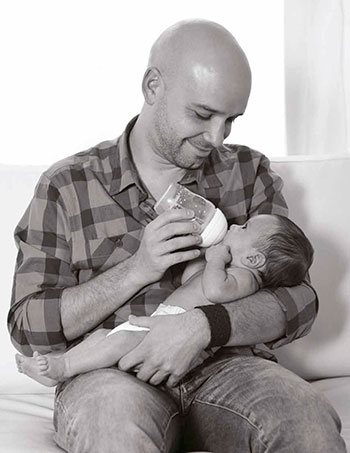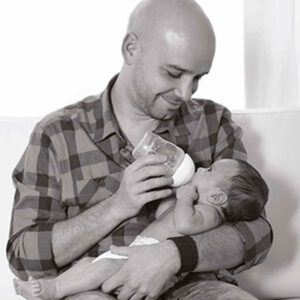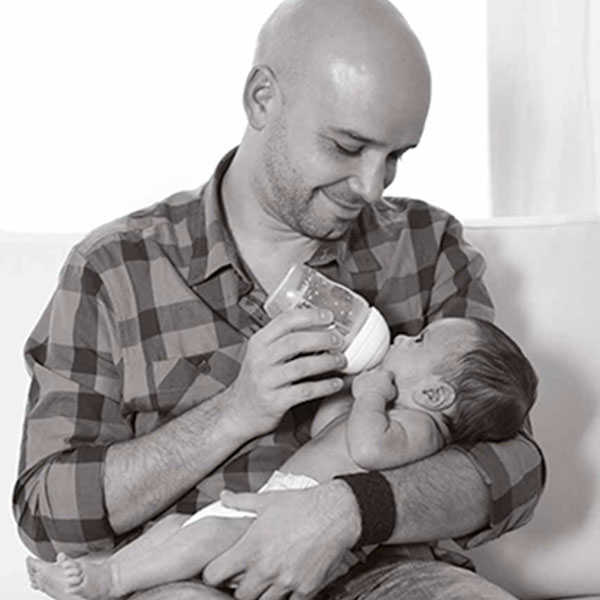By Gary Barker and Michael Kimmel
Originally posted on CNN

Earlier this year, several major corporations sponsored a night in one of the Smithsonian’s flagship museums in Washington, D.C., for more than 400 “daddy bloggers.” Their motivation? Fathers are now as likely as mothers to be deciding what food, toys, children’s books and clothing to buy.
And these dad bloggers know just how to reach other fathers. Some of the corporations on hand were bragging about their newly expanded paid parental leave for mothers and fathers — an increasingly necessary benefit to offer as they compete for highly qualified talent among twenty-somethings.
But just a few short miles away from the Smithsonian, in southeast Washington, fathers face a different reality: They are absent in 73% of households, and nearly one in 10 is currently incarcerated. Here, fathers struggle with having a steady job with a living wage and being able to pay child support.
Call this the tale of two fatherhoods. For this Father’s Day, we all need to bring a clearer picture into focus of all the ways men are taking on fatherhood in America.
Much has been written recently about the rapid increase in men’s participation in families and as fathers. Research we compiled for the recently launched State of America’s Fathers report finds that involved and engaged fatherhood has become the norm for some families in the United States. The study, the first of its kind, combined existing studies with new findings from the 2016 National Study of the Changing Workforce (NCSW) completed by the Families and Work Institute, a sample of nearly 2,000 employed women and men over 18 years of age. According to our data, 50% of currently partnered American fathers now self-identify as either sharing responsibility with their female partners or as their children’s primary caregiver.
Then there are the forgotten fathers. All told, there are between 8 and 10 million nonresident fathers in America, including both divorced and never-married dads. The vast majority of these are lower-income and less-educated men. Indeed, because of the challenges of finding stable employment, the majority of men who lack a four-year college degree will become nonresident fathers.
Included in these figures as well are the dramatically high numbers of incarcerated fathers. More than 2.5 million children in the United States have a parent in prison: 92% of these incarcerated parents are fathers, and due to racial biases and other factors, more than 60% of those in prison are people of color.
The issue of immigration also impacts American fatherhood. The number of unauthorized immigrant parents living with their U.S. citizen children has more than doubled in less than two decades: from 1.3 million in 1995 to 3.3 million in 2012. These mothers and fathers may be present in the household but live under the shadow of deportation. In addition, in 2013 there were 17.6 million children of immigrants living in the United States. Add to this the fathers who immigrate to the United States for work without their families and become nonresidential fathers in order to send needed remittances home.
There are some important things we should know about these forgotten fathers. First and foremost, “nonresident” is not the same as “absent.” A nationally representative sample from 2010 found that the largest proportions of nonresident fathers are consistently very active in the lives of their children. And for those who think being a low-income, nonresident father of color is synonymous with absent fatherhood, research finds the opposite. As compared to poor nonresident white fathers, many poor nonresident black fathers are more likely to see their children on a regular basis than white nonresident fathers, not less.
For years, the policy response to the rise nonresidential fathers has been mostly to chastise them if they don’t pay child support— the “dead-beat dad” discourse. Of course, nonresident fathers’ financial support — via court-ordered child support payments or other informal contributions — does meaningfully benefit the health and development of both children and their mothers. But the research of Ron Mincy and his colleagues at Columbia University, who analyzed the largest data set on nonresidential fathers for the State of America’s Fathers report, find that the informal support low-income fathers provide — which includes informal financial contributions as well as care – make nearly as big a difference in their children’s lives as their formal financial contributions do.
The point is this: The “deadbeat dad” narrative doesn’t tell the full story. Fathers earning less than $20,000 per year comprise the overwhelming majority of those in arrears on child support — they’re not deadbeats, they’re dead broke. Furthermore, studies find that while mothers value and want the financial support from nonresident fathers, a great many single mothers in low-income families report that they want their children’s nonresident fathers to be involved in their children’s lives first and foremost as co-caregivers.
When a low-income father fails to make child support payments, billions of dollars of federal and state mechanisms to enforce these payments snap into action. Yet investing such resources into ensuring timely payments of child support misses the point, since such mechanisms do nothing to shift the underlying causal factors of stagnant earnings, unemployment, incarceration and economic disadvantage.
The prevalent image of the absent and deadbeat dad needs to be changed once and for all. The majority of nonresident fathers are not absent, and of those who are absent, it is rarely of their own choosing. Indeed, for the most part, it’s not that nonresident fathers are failing their children. It’s that our policies and our economy are failing fathers and children alike.
As we celebrate Father’s Day, we should acknowledge that fathers are doing a greater share of the hands-on caregiving than ever before and that many highly visible corporations, and a few leading states, are stepping up and offering paid leave for fathers and mothers. But let’s not lose sight of the country’s poorest fathers. What they desire is exactly the same as those daddy bloggers in the Smithsonian: to be engaged in the daily lives of their children.

